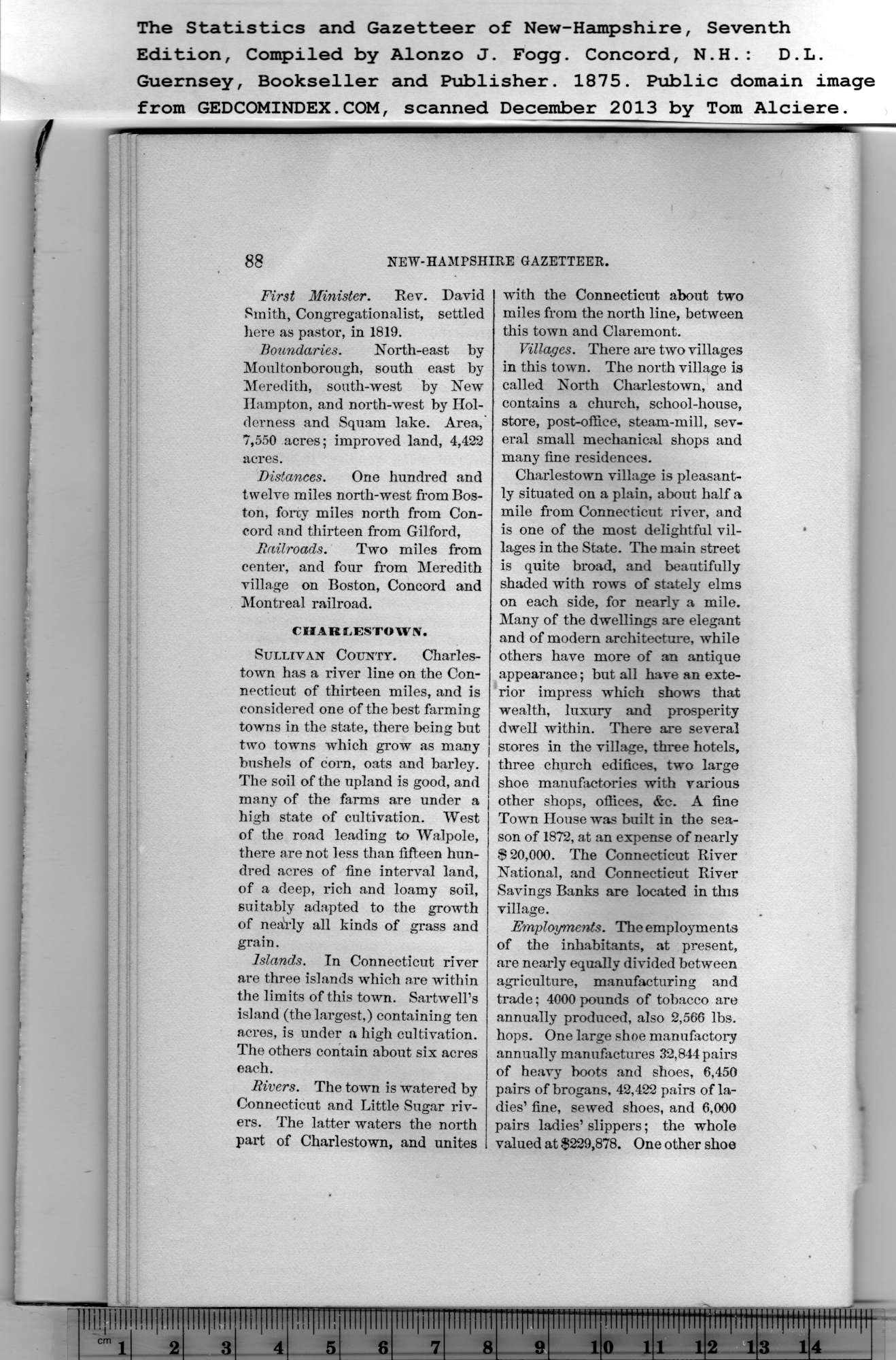|
First Minister. Rev. David
Smith, Congregationalist, settled
here as pastor, in 1819.
The Statistics and Gazetteer of New-Hampshire, Seventh
Edition, Compiled by Alonzo J. Fogg. Concord, N.H.: D.L.
88 NEW-HAMPSHIRE GAZETTEER.
Boundaries. North-east by
Moultonborough, south east by
Meredith, south-west by New
Hampton, and north-west by Hol-
derness and Squam lake. Area,
7,550 acres; improved land, 4,422
acres.
Distances. One hundred and
twelve miles north-west from Bos-
ton, forty miles north from Con-
cord and thirteen from Gilford,
Railroads. Two miles from
center, and four from Meredith
village on Boston, Concord and
Montreal railroad.
CHARLESTOWN.
Sullivan County. Charles-
town has a river line on the Con-
necticut of thirteen miles, and is
considered one of the best farming
towns in the state, there being but
two towns which grow as many
bushels of corn, oats and barley.
The soil of the upland is good, and
many of the farms are under a
high state of cultivation. West
of the road leading to Walpole,
there are not less than fifteen hun-
dred acres of fine interval land,
of a deep, rich and loamy soil,
suitably adapted to the growth
of neaTly all kinds of grass and
grain.
Islands. In Connecticut river
are three islands which are within
the limits of this town. Sartwell’s
island (the largest,) containing ten
acres, is under a high cultivation.
The others contain about six acres
each.
Rivers. The town is watered by
Connecticut and Little Sugar riv-
ers. The latter waters the north
part of Charlestown, and unites
with the Connecticut about two
miles from the north line, between
this town and Claremont. |
Villages. There are two villages
in this town. The north village is
called North Charlestown, and
contains a church, school-house,
store, post-office, steam-mill, sev-
eral small mechanical shops and
many fine residences.
Charlestown village is pleasant-
ly situated on a plain, about half a
mile from Connecticut river, and
is one of the most delightful vil-
lages in the State. The main street
is quite broad, and beautifully
shaded with rows of stately elms
on each side, for nearly a mile.
Many of the dwellings are elegant
and of modern architecture, while
others have more of an antique
appearance; but all have an exte-
rior impress which shows that
wealth, luxury and prosperity
dwell within. There are several
stores in the village, three hotels,
three church edifices, two large
shoe manufactories with various
other shops, offices, &c. A fine
Town House was built in the sea-
son of 1872, at an expense of nearly
$20,000. The Connecticut River
National, and Connecticut River
Savings Banks are located in this
village.
Employments. The employments
of the inhabitants, at present,
are nearly equally divided between
agriculture, manufacturing and
trade; 4000 pounds of tobacco are
annually produced, also 2,566 lbs.
hops. One large shoe manufactory
annually manufactures 32,844 pairs
of heavy hoots and shoes, 6,450
pairs of brogans. 42,422 pairs of la-
dies’ fine, sewed shoes, and 6,000
pairs ladies’ slippers; the whole
valued at $229,878. One other shoe |
